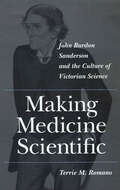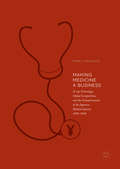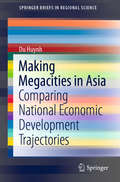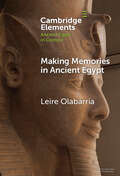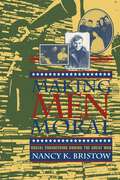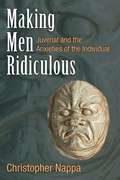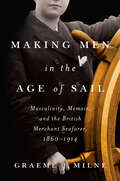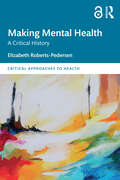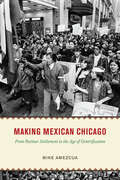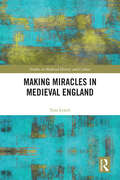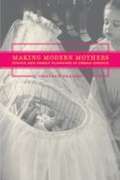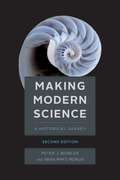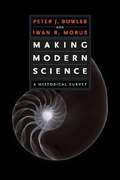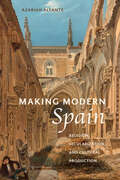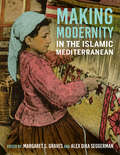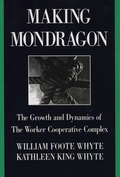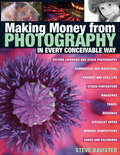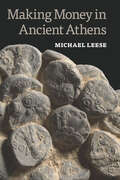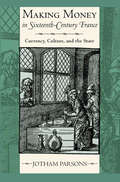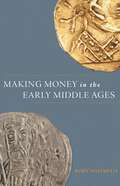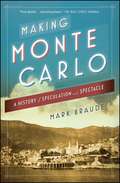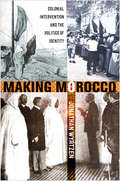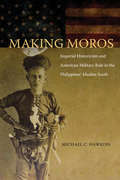- Table View
- List View
Making Medicine Scientific: John Burdon Sanderson and the Culture of Victorian Science
by Terrie M. RomanoA biography of the English physician and scientist and a history of the advancement of science in the Victorian era.In Victorian Britain, scientific medicine encompassed an array of activities, from laboratory research and the use of medical technologies through the implementation of sanitary measures that drained canals and prevented the adulteration of milk and bread. Although most practitioners supported scientific medicine, controversies arose over where decisions should be made, in the laboratory or in the clinic, and by whom—medical practitioners or research scientists. In this study, Terrie Romano uses the life and eclectic career of Sir John Burdon Sanderson (1829-1905) to explore the Victorian campaign to make medicine scientific.Sanderson, a prototypical Victorian, began his professional work as a medical practitioner and Medical Officer of Health in London, then became a pathologist and physiologist and eventually the Regius Professor of Medicine at Oxford. His career illustrates the widespread support during this era for a medicine based on science. In Making Medicine Scientific, Romano argues this support was fueled by the optimism characteristic of the Victorian age, when the application of scientific methods to a range of social problems was expected to achieve progress. Dirt and disease as well as the material culture of experimentation —from frogs to photographs—represent the tangible context in which Sanderson lived and worked. Romano’s detailed portrayal reveals a fascinating figure who embodied the untidy nature of the Victorian age’s shift from an intellectual system rooted in religion to one based on science.“A useful entry in the canon of science and public health . . . an antidote to the hubris of recent claims of accomplishment.” —Choice
Making Medicine a Business
by Pierre-Yves DonzéThis book goes back to the origins of the transformation of health and medicine into a business, during the first part of the twentieth century, focusing on the example of Japan. In the past hundred years, medicine has gone from being a charitable activity to a large economic sector, amounting to 12–15% of the GDP in many developed countries, and one of the fastest-growing businesses around the world. Despite the mounting presence of the medical industry, there is a lack of academic work detailing this major transformation. The objective of this book is to fill this gap and address the following question: how did medicine become a business? Using over ten years of research in the field, Pierre-Yves Donzé argues that economic factors and business factors were decisive in transforming the way that medicine enters our lives. This book will be of interest to historians of medicine, business historians, health economists, scholars in medical humanities, and more.
Making Megacities in Asia: Comparing National Economic Development Trajectories (SpringerBriefs in Regional Science)
by Du HuynhThis book analyses and compares the development paths of five major cities in East and Southeast Asia since the early 1960s, including Ho Chi Minh City, Jakarta, Manila, Seoul, and Shanghai. In examining these five cases through a carefully crafted conceptual framework, the author excavates an understanding of the dynamics that have enabled Seoul and Shanghai to become highly competitive as major engines of economic growth, while simultaneously accounting for why the other three cities have faced numerous problems in terms of meeting their development goals. Presenting both quantitative and qualitative data to trace the course of changes between 1960 and 2015, the case studies curate six possible explanations for the different cities’ developmental trajectories. The book considers the national development strategy matters to the development of cities and positions the share of budget revenue retained for cities’ expenditure as critical. The author demonstrates that consistently pursuing long-term strategies is important, and that public entrepreneurship with powerful supporting coalitions is vital. The book illustrates how master plans have played limited roles in the building of cities, and that fragmented governments are often at the root of the problems facing a city’s development. This book will be highly relevant to researchers in international and Asian urban development.
Making Memories in Ancient Egypt (Elements in Ancient Egypt in Context)
by Leire OlabarriaMemory is a fascinating way to approach modern and ancient cultures, as it raises questions about what, why, and how individuals and groups remember. Egyptology has had a major impact on the development of memory studies, with Jan Assmann's notion of cultural memory becoming a widespread model within the humanities. Despite this outstanding contribution of Egyptology to memory studies, remarkably few recent works on ancient Egypt deal with memory from a theoretical and methodological point of view. This Element provides a general introduction to memory, followed by a discussion of the role of materiality and performativity in the process of remembering. A case study from Middle Kingdom Abydos illustrates how memory can be embodied in the monumental record of ancient Egypt. The purpose of this Element is to present an up-to-date introduction to memory studies in Egyptology and to invite the reader to rethink how and why memory matters.
Making Men Moral: Social Engineering During the Great War (The American Social Experience #8)
by Nancy K. BristowOn May 29, 1917, Mrs. E. M. Craise, citizen of Denver, Colorado, penned a letter to President Woodrow Wilson, which concluded, We have surrendered to your absolute control our hearts' dearest treasures--our sons. If their precious bodies that have cost us so dear should be torn to shreds by German shot and shells we will try to live on in the hope of meeting them again in the blessed Country of happy reunions. But, Mr. President, if the hell-holes that infest their training camps should trip up their unwary feet and they be returned to us besotted degenerate wrecks of their former selves cursed with that hell-born craving for alcohol, we can have no such hope. Anxious about the United States' pending entry into the Great War, fearful that their sons would be polluted by the scourges of prostitution, venereal disease, illicit sex, and drink that ran rampant in the training camps, countless Americans sent such missives to their government officials. In response to this deluge, President Wilson created the Commission on Training Camp Activities to ensure the purity of the camp environment. Training camps would henceforth mold not only soldiers, but model citizens who, after the war, would return to their communities, spreading white, urban, middle-class values throughout the country. What began as a federal program designed to eliminate sexually transmitted diseases soon mushroomed into a powerful social force intent on replacing America's many cultures with a single, homogenous one. Though committed to the positive methods of education and recreation, the reformers did not hesitate to employ repression when necessary. Those not conforming to the prescribed vision of masculinity often faced exclusion from the reformers' idealized society, or sometimes even imprisonment. Social engineering ruled the day. Combining social, cultural, and military history and illustrating the deep divisions among reformers themselves, Nancy K. Bristow, with the aid of dozens of evocative photographs, here brings to life a pivotal era in the history of the U.S., revealing the complex relationship between the nation's competing cultures, progressive reform efforts, and the Great War.
Making Men Ridiculous: Juvenal and the Anxieties of the Individual
by Christopher NappaWriting during the reign of emperors Trajan and Hadrian, Juvenal drew on Roman legend and the history of preceding imperial dynasties as a means of scrutinizing cultural upheavals in the Rome of his day. Tacky foreigners, the nouveaux riches, women who don’t know their place, bloodthirsty—even crazy—emperors and their (often worse) wives confront the reader at every turn, along with bad poets, corrupt aristocrats, gladiators, whores, false philosophers, sad-sack men in the street, and slaves. Juvenal’s poetry set the tone, and often the topics, for satirists throughout the centuries of European literature. In his sixteen verse satires, Juvenal presents speakers who decry the breakdown in traditional Roman values and the status of Roman men as they are confronted by upstart foreigners, devious and deviant women, class traitors, the power of the imperial household, and even the body itself. The satirist castigates vice and immorality even as he revels in describing them. This book locates Juvenal’s targets among the matrices of birth, wealth, class, gender, and ethnicity and walks carefully through a number of his most arresting vignettes in order to show not only what, but how, he satirizes. Moreover, the analysis shows that Juvenal’s portraits sometimes escape his grasp, and, as often as not, he ends up undermining the voice with which he speaks and the values he claims to hold dear. Individual chapters look at the satirist himself, rebellious bodies, disgraced aristocrats, uppity (even murderous) wives, and the necessary but corrupting power of money. The conclusion considers the endurance of both the targets and the rhetoric behind them in the modern world. Making Men Ridiculous will interest scholars and advanced students of ancient satire, later European satire, imperial Roman culture and literature, and class, gender, and sexuality in the ancient world.
Making Men in the Age of Sail: Masculinity, Memoir, and the British Merchant Seafarer, 1860–1914
by Graeme J. MilneMyths and stereotypes surrounding seafarers in the Age of Sail persist to this day. Sailors were celebrated for their courage, strength, and skill, yet condemned for militancy, vice, and fecklessness. As sail gave way to steam, sailing-ship mariners became nostalgic symbols of maritime prowess and heritage, representing a timeless, heroic masculinity in an era when the modernizing industrial world was challenging assumptions about gender, class, work, and society.Drawing on British seafaring memoirs from the late nineteenth century, Making Men in the Age of Sail argues that maritime writing moulded the reading public’s image of the merchant seaman. Authors chronicled their lives as they grew from boy sailors to trained seafarers, telling colourful tales of the men they worked with – most never doubted that the sailing ship had made them better men. Their testimony reinforced and preserved conservative perspectives on seafaring manhood as Britain’s economic and technological priorities continued to evolve in the new steamship age.Offering a gender analysis of the image of the seafarer, Making Men in the Age of Sail brings the history of British sailors into wider debates about modernity and masculinity.
Making Mental Health: A Critical History (Critical Approaches to Health)
by Elizabeth Roberts-PedersenMaking Mental Health: A Critical History historicises mental health by examining the concept from the ‘madness’ of the late nineteenth century to the changing ideas about its contemporary concerns and status. It argues that a critical approach to the history of psychiatry and mental health shows them to constitute a dual clinical-political project that gathered pace over the course of the twentieth century and continues to resonate in the present. Drawing on scholarship across several areas of historical inquiry as well as historical and contemporary clinical literature, the book uses a thematic approach to highlight decisive moments that demonstrate the stakes of this engagement in Anglo-American contexts.By tracing the (unfinished) history of institutions, the search for cures for psychiatric distress, the growing interest of the nation-state in mental health, the history of attempts to globalise psychiatry, the controversies over the politics of diagnostic categories that erupted in the 1960s and 1970s, and the history of theorising about the relationship between the psyche and the market, the book offers a comprehensive account of the evolution of mental health into a commonplace concern.Addressing key questions in the fields of history, medical humanities, and the social sciences, as well as in the psychiatry disciplines themselves, the book is an essential contribution to an ongoing conversation about mental distress and its meanings.The Open Access version of this book, available at http://www.taylorfrancis.com, has been made available under a Creative Commons Attribution-Non Commercial-No Derivatives (CC-BY-NC-ND) 4.0 license.
Making Mexican Chicago: From Postwar Settlement to the Age of Gentrification (Historical Studies of Urban America)
by Mike AmezcuaAn exploration of how the Windy City became a postwar Latinx metropolis in the face of white resistance. Though Chicago is often popularly defined by its Polish, Black, and Irish populations, Cook County is home to the third-largest Mexican-American population in the United States. The story of Mexican immigration and integration into the city is one of complex political struggles, deeply entwined with issues of housing and neighborhood control. In Making Mexican Chicago, Mike Amezcua explores how the Windy City became a Latinx metropolis in the second half of the twentieth century. In the decades after World War II, working-class Chicago neighborhoods like Pilsen and Little Village became sites of upheaval and renewal as Mexican Americans attempted to build new communities in the face of white resistance that cast them as perpetual aliens. Amezcua charts the diverse strategies used by Mexican Chicagoans to fight the forces of segregation, economic predation, and gentrification, focusing on how unlikely combinations of social conservatism and real estate market savvy paved new paths for Latinx assimilation. Making Mexican Chicago offers a powerful multiracial history of Chicago that sheds new light on the origins and endurance of urban inequality.
Making Mexican Chicago: From Postwar Settlement to the Age of Gentrification (Historical Studies of Urban America)
by Mike AmezcuaAn exploration of how the Windy City became a postwar Latinx metropolis in the face of white resistance. Though Chicago is often popularly defined by its Polish, Black, and Irish populations, Cook County is home to the third-largest Mexican-American population in the United States. The story of Mexican immigration and integration into the city is one of complex political struggles, deeply entwined with issues of housing and neighborhood control. In Making Mexican Chicago, Mike Amezcua explores how the Windy City became a Latinx metropolis in the second half of the twentieth century. In the decades after World War II, working-class Chicago neighborhoods like Pilsen and Little Village became sites of upheaval and renewal as Mexican Americans attempted to build new communities in the face of white resistance that cast them as perpetual aliens. Amezcua charts the diverse strategies used by Mexican Chicagoans to fight the forces of segregation, economic predation, and gentrification, focusing on how unlikely combinations of social conservatism and real estate market savvy paved new paths for Latinx assimilation. Making Mexican Chicago offers a powerful multiracial history of Chicago that sheds new light on the origins and endurance of urban inequality.
Making Miracles in Medieval England (Studies in Medieval History and Culture)
by Tom LynchThe cult of the saints was central to medieval Christianity largely due to the miraculous. Saints were members of the elect of heaven and could intercede with God on the behalf of supplicants. Whilst people visited shrines and prayed to the saints for many reasons it was the hope of intercession and the praise of miracles past which drove the cult of the saints. This book examines how a person solicited aid from a saint, how they might give thanks and the ways in which post-mortem miracles structured the cult of the saints. A huge number of miracle stories survive from medieval England, in dedicated collections as well as in saints’ lives and other source material. This corpus is full of stories of human relationships, vulnerability and deliverance of people from all parts of society. These stories reveal all manner of details about ordinary people in extraordinary circumstances. They also show us how people navigated the world with the aid of the saints. Saints could help with wayward livestock, lost property or lawsuits as well as fire, plague and injury. They could also protect members of their communities, correct lapses by their custodians and even kill those who mistreated them. A respectful relationship with a saint could be proof against any problem. Making Miracles in Medieval England will appeal to all those interested in religious practices in medieval England, medieval English culture, and medieval perceptions of miracles.
Making Modern Mothers: Ethics and Family Planning in Urban Greece
by Heather PaxsonIn Greece, women speak of mothering as "within the nature" of a woman. But this durable association of motherhood with femininity exists in tension with the highest incidence of abortion and one of the lowest fertility rates in Europe. In this setting, how do women think of themselves as proper individuals, mothers, and Greek citizens? In this anthropological study of reproductive politics and ethics in Athens, Greece, Heather Paxson tracks the effects of increasing consumerism and imported biomedical family planning methods, showing how women's "nature" is being transformed to meet crosscutting claims of the contemporary world. Locating profound ambivalence in people's ethical evaluations of gender and fertility control, Paxson offers a far-reaching analysis of conflicting assumptions about what it takes to be a good mother and a good woman in modern Greece, where assertions of cultural tradition unfold against a backdrop of European Union integration, economic struggle, and national demographic anxiety over a falling birth rate.
Making Modern Science, Second Edition: A Historical Survey
by Peter J. Bowler Iwan Rhys MorusIn this new edition of the top-selling coursebook, seasoned historians Peter J. Bowler and Iwan Rhys Morus expand on their authoritative survey of how the development of science has shaped our world. Exploring both the history of science and its influence on modern thought, the authors chronicle the major developments in scientific thinking, from the revolutionary ideas of the seventeenth century to contemporary issues in genetics, physics, and more. Thoroughly revised and expanded, the second edition draws on the latest research and scholarship. It also contains two entirely new chapters: one that explores the impact of computing on the development of science, and another that shows how the West used science and technology as tools for geopolitical expansion. Designed for entry-level college courses and as a single-volume introduction for the general reader, Making Modern Science presents the history of science not as a series of names and dates, but as an interconnected and complex web of relationships joining science and society.
Making Modern Science, Second Edition: A Historical Survey
by Peter J. Bowler Iwan Rhys MorusIn this new edition of the top-selling coursebook, seasoned historians Peter J. Bowler and Iwan Rhys Morus expand on their authoritative survey of how the development of science has shaped our world. Exploring both the history of science and its influence on modern thought, the authors chronicle the major developments in scientific thinking, from the revolutionary ideas of the seventeenth century to contemporary issues in genetics, physics, and more. Thoroughly revised and expanded, the second edition draws on the latest research and scholarship. It also contains two entirely new chapters: one that explores the impact of computing on the development of science, and another that shows how the West used science and technology as tools for geopolitical expansion. Designed for entry-level college courses and as a single-volume introduction for the general reader, Making Modern Science presents the history of science not as a series of names and dates, but as an interconnected and complex web of relationships joining science and society.
Making Modern Science: A Historical Survey
by Peter J. Bowler Iwan R. MorusA textbook about the history of modern science with cross-references. The book is divided into two parts, one on episodes, the other on themes. It covers all major developments in scientific thinking--evolutionism, genetics, nuclear physics, and modern cosmology.
Making Modern Spain: Religion, Secularization, and Cultural Production (Campos Ibéricos: Bucknell Studies in Iberian Literatures and Cultures)
by Azariah AlfanteIn this elegantly written study, Alfante explores the work of select nineteenth-century writers, intellectuals, journalists, politicians, and clergy who responded to cultural and spiritual shifts caused by the movement toward secularization in Spain. Focusing on the social experience, this book probes the tensions between traditionalism and liberalism that influenced public opinion of the clergy, sacred buildings, and religious orders. The writings of Cecilia Böhl de Faber (Fernán Caballero), Gustavo Adolfo Bécquer, Benito Pérez Galdós, and José María de Pereda addressed conflicts between modernizing forces and the Catholic Church about the place of religion and its signifiers in Spanish society. Foregrounding expropriation (government confiscation of civil and ecclesiastical property) and exclaustration (the expulsion of religious communities), and drawing on archival research, the history of disentailment, cultural theory, memory studies, and sociology, Alfante demonstrates how Spain’s liberalizing movement profoundly influenced class mobility and faith among the populace.
Making Modernity in the Islamic Mediterranean
by Marcus Milwright Peter Christensen Ünver Rüstem Gülru Çakmak Hala Auji Emily Neumeier Jessica Gerschultz Ashley Dimmig David J. RoxburghThe Islamic world's artistic traditions experienced profound transformation in the 19th century as rapidly developing technologies and globalizing markets ushered in drastic changes in technique, style, and content. Despite the importance and ingenuity of these developments, the 19th century remains a gap in the history of Islamic art. To fill this opening in art historical scholarship, Making Modernity in the Islamic Mediterranean charts transformations in image-making, architecture, and craft production in the Islamic world from Fez to Istanbul. Contributors focus on the shifting methods of production, reproduction, circulation, and exchange artists faced as they worked in fields such as photography, weaving, design, metalwork, ceramics, and even transportation. Covering a range of media and a wide geographical spread, Making Modernity in the Islamic Mediterranean reveals how 19th-century artists in the Middle East and North Africa reckoned with new tools, materials, and tastes from local perspectives.
Making Mondragón: The Growth and Dynamics of the Worker Cooperative Complex
by William Foote Whyte Kathleen King WhyteSince its founding in 1956 in Spain's Basque region, the Mondragón Corporation has been a touchstone for the international cooperative movement. Its nearly three hundred companies and organizations span areas from finance to education. In its industrial sector Mondragón has had a rich experience over many years in manufacturing products as varied as furniture, kitchen equipment, machine tools, and electronic components and in printing, shipbuilding, and metal smelting. Making Mondragón is a groundbreaking look at the history of worker ownership in the Spanish cooperative. First published in 1988, it remains the best source for those looking to glean a rich body of ideas for potential adaptation and implementation elsewhere from Mondragón's long and varied experience. This second edition, published in 1991, takes into account the major structural and strategic changes that were being implemented in 1990 to allow the enterprise to compete successfully in the European common market. Mondragón has created social inventions and developed social structures and social processes that have enabled it to overcome some of the major obstacles faced by other worker cooperatives in the past. William Foote Whyte and Kathleen King Whyte describe the creation and evolution of the Mondragón cooperatives, how they have changed through decades of experience, and how they have struggled to maintain a balance between their social commitments and economic realities. The lessons of Mondragón apply most clearly to worker cooperatives and other employee-owned firms, but also extend to regional development and stimulating and supporting entrepreneurship, whatever the form of ownership.
Making Money from Photography in Every Conceivable Way
by Steve BavisterIn this comprehensive manual, Steve Bavister gives an invaluable insight into the business of being a photographer, with tips and examples of how to take great pictures in every genre, including:Advice on shooting and selling stock photographyHow to get your work into picture librariesSuccessful strategies for wedding and portrait photographyInspirational, high-quality examples from top photographersTips on running your own photography business--This text refers to an out of print or unavailable edition of this title.
Making Money in Ancient Athens
by Michael LeeseGiven their cultural, intellectual, and scientific achievements, surely the Greeks were able to approach their economic affairs in a rational manner like modern individuals? Since the nineteenth century, many scholars have argued that premodern people did not behave like modern businesspeople, and that the “stagnation” that characterized the economy prior to the Industrial Revolution can be explained by a prevailing noneconomic mentality throughout premodern (and nonwestern) societies. This view, which simultaneously extols the “sophistication” of the modern West, relegates all other civilizations to the status of economic backwardness. But the evidence from ancient Athens, which is one of the best-documented societies in the premodern world, tells a very different story: one of progress, innovation, and rational economic strategies. Making Money in Ancient Athens examines in the most comprehensive manner possible the voluminous source material that has survived from Athens in inscriptions, private lawsuit speeches, and the works of philosophers like Aristotle and Plato. Inheritance cases that detail estate composition and investment choices, and maritime trade deals gone wrong, provide unparalleled glimpses into the specific factors that influenced Athenians at the level of the economic decision-making process itself, and the motivations that guided the specific economic transactions attested in the source material. Armed with some of the most thoroughly documented case studies and the richest variety of source material from the ancient Greek world, Michael Leese argues that the evidence overwhelmingly demonstrates that ancient Athenians achieved the type of long-term profit and wealth maximization and continuous reinvestment of profits into additional productive enterprise that have been argued as unique to (and therefore responsible for) the modern industrial-capitalist system.
Making Money in Sixteenth-Century France: Currency, Culture, and the State
by Jotham ParsonsCoinage and currency—abstract and socially created units of value and power—were basic to early modern society. By controlling money, the people sought to understand and control their complex, expanding, and interdependent world. In Making Money in Sixteenth-Century France, Jotham Parsons investigates the creation and circulation of currency in France. The royal Cour des Monnaies centralized monetary administration, expanding its role in the emerging modern state during the sixteenth century and assuming new powers as an often controversial repository of theoretical and administrative expertise. The Cour des Monnaies, Parsons shows, played an important role in developing the contemporary understanding of money, as a source of both danger and opportunity at the center of economic and political life. More practically, the Monnaies led generally successful responses to the endemic inflation of the era and the monetary chaos of a period of civil war. Its work investigating and prosecuting counterfeiters shone light into a picaresque world of those who used the abstract and artificial nature of money for their own ends. Parson's broad, multidimensional portrait of money in early modern France also encompasses the literature of the age, in which money’s arbitrary and dangerous power was a major theme.
Making Money in the Early Middle Ages
by Rory NaismithAn examination of coined money and its significance to rulers, aristocrats and peasants in early medieval EuropeBetween the end of the Roman Empire in the fifth century and the economic transformations of the twelfth, coined money in western Europe was scarce and high in value, difficult for the majority of the population to make use of. And yet, as Rory Naismith shows in this illuminating study, coined money was made and used throughout early medieval Europe. It was, he argues, a powerful tool for articulating people’s place in economic and social structures and an important gauge for levels of economic complexity. Working from the premise that using coined money carried special significance when there was less of it around, Naismith uses detailed case studies from the Mediterranean and northern Europe to propose a new reading of early medieval money as a point of contact between economic, social, and institutional history.Naismith examines structural issues, including the mining and circulation of metal and the use of bullion and other commodities as money, and then offers a chronological account of monetary development, discussing the post-Roman period of gold coinage, the rise of the silver penny in the seventh century and the reconfiguration of elite power in relation to coinage in the tenth and eleventh centuries. In the process, he counters the conventional view of early medieval currency as the domain only of elite gift-givers and intrepid long-distance traders. Even when there were few coins in circulation, Naismith argues, the ways they were used—to give gifts, to pay rents, to spend at markets—have much to tell us.
Making Monte Carlo: A History of Speculation and Spectacle
by Mark BraudeA rollicking narrative history of Monte Carlo, capturing its nineteenth-century rise as the world's first modern casino-resort and its Jazz Age heyday as infamous playground of the rich.Monte Carlo has long been known as a dazzling playground for the rich and famous. Less well known are the shrewd and often ruthless strategies that went into creating such a potent symbol of luxury and cosmopolitan glamour. As historian Mark Braude reveals in his entertaining and informative Making Monte Carlo, the world's first modern casino-resort started as an unlikely prospect--with the legalization of gambling in tiny Monaco in 1855--and eventually emerged as the most glamorous gambling destination of the Victorian era. The resort declined in the wake of WWI, and was reinvented, again, to suit the styles and desires of the new Jazz Age tastemakers, such as F. Scott and Zelda Fitzgerald, Gerald and Sarah Murphy, and Coco Chanel. Along the way, we encounter a colorful cast of characters, including the fast-talking Francois Blanc (a professional gambler, stock market manipulator, and founder of Monte Carlo); Basil Zaharoff (notorious munitions dealer and possible secret owner of the casino in the 1920s); Elsa Maxwell (a brash society figure and Hollywood maven, hired as the casino's publicist); Réné Léon (a visionary Jewish businessman, who revitalized the resort after WWI); Jean Cocteau, Pablo Picasso, and other satellite members of Serge Diaghilev's Ballet Russes dance company; as well as Cole Porter, Ernest Hemingway and other American expats who 'colonized' the Riviera in the 1920s. A rollercoaster history of how a small, rural town grew into the prosperous resort epicenter of the late nineteenth century and rose again to greatness out of the ashes of WWI, Making Monte Carlo is a classic rags-to-riches tale set in the most scenic of European settings.
Making Morocco: Colonial Intervention and the Politics of Identity
by Jonathan WyrtzenHow did four and a half decades of European colonial intervention transform Moroccan identity? As elsewhere in North Africa and in the wider developing world, the colonial period in Morocco (1912–1956) established a new type of political field in which notions about and relationships among politics and identity formation were fundamentally transformed. Instead of privileging top-down processes of colonial state formation or bottom-up processes of local resistance, the analysis in Making Morocco focuses on interactions between state and society. Jonathan Wyrtzen demonstrates how, during the Protectorate period, interactions among a wide range of European and local actors indelibly politicized four key dimensions of Moroccan identity: religion, ethnicity, territory, and the role of the Alawid monarchy. This colonial inheritance is reflected today in ongoing debates over the public role of Islam, religious tolerance, and the memory of Morocco's Jews; recent reforms regarding women’s legal status; the monarchy’s multiculturalist recognition of Tamazight (Berber) as a national language alongside Arabic; the still-unresolved territorial dispute over the Western Sahara; and the monarchy’s continued symbolic and practical dominance of the Moroccan political field.
Making Moros: Imperial Historicism and American Military Rule in the Philippines' Muslim South
by Michael HawkinsMaking Moros offers a unique look at the colonization of Muslim subjects during the early years of American rule in the southern Philippines. Hawkins argues that the ethnological discovery, organization, and subsequent colonial engineering of Moros was highly contingent on developing notions of time, history, and evolution, which ultimately superseded simplistic notions about race. He also argues that this process was highly collaborative, with Moros participating, informing, guiding, and even investing in their configuration as modern subjects. Drawing on a wealth of archival sources from both the United States and the Philippines, Making Moros presents a series of compelling episodes and gripping evidence to demonstrate its thesis. Readers will find themselves with an uncommon understanding of the Philippines' Muslim South beyond its usual tangential place as a mere subset of American empire.
